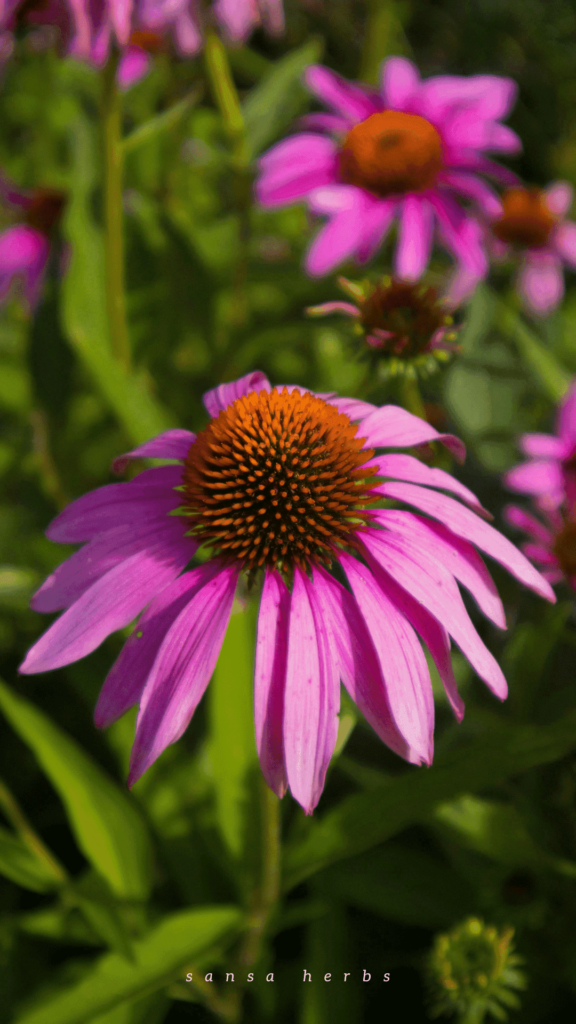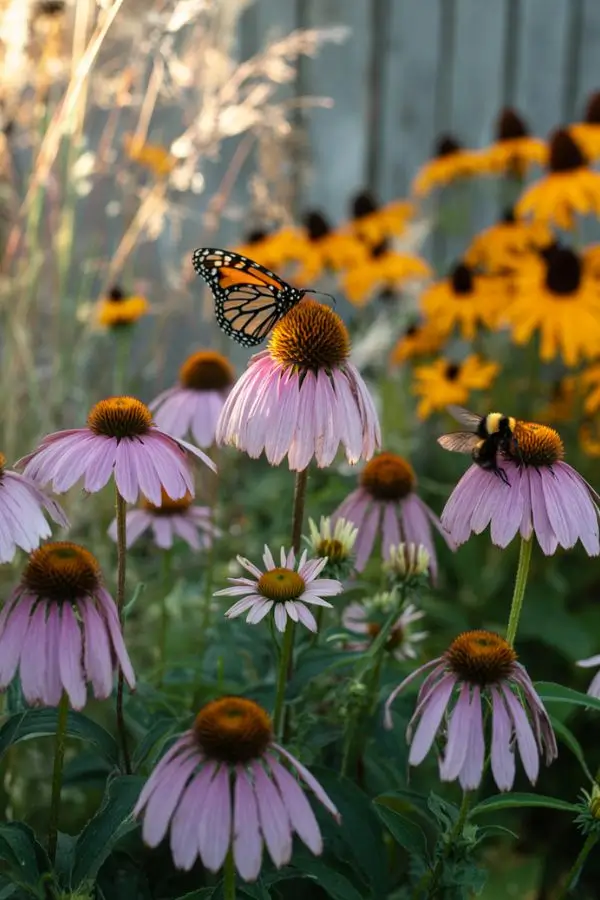Different types of echinacea offer unique benefits for your garden and your herbal medicine collection. While all echinacea varieties support immune health, each species has its own strengths. Some are easier to grow, others are better for tinctures, and a few add bold color to your flower beds.
Growing Echinacea? Don’t miss our guide on the 7 Common Echinacea Growing Mistakes so you can avoid setbacks and grow healthy, thriving plants.

In this guide, you’ll discover how Echinacea purpurea, Echinacea angustifolia, and Echinacea pallida differ in their uses, growing habits, and ideal conditions so you can choose the one that fits your needs best.
Further reading: Echinacea Companion Plants
Understanding the Different Types of Echinacea and Their Uses
Why Echinacea Variety Matters
Echinacea isn’t a one-size-fits-all herb. With more than 10 wild species, each one brings something different to the garden and your apothecary. Native American traditions and modern herbal practices often favor specific types based on their strengths.
These three are the most widely used today:
- Echinacea purpurea: Echinacea purpurea is one of the most popular types of echinacea used both medicinally and ornamentally. → PubMed
- Echinacea angustifolia: Among the different types of echinacea, angustifolia is known for its potent roots and deep immune benefits.
- Echinacea pallida: If you’re exploring the different types of echinacea and their uses in drought-prone areas, pallida is worth considering.
Each one supports health in different ways and grows best under different conditions. If you’re just getting started, E. purpurea is often included in beginner-friendly seed kits like the Medicinal Garden Kit because it’s easy to grow and quick to flower.
Start with E. purpurea in your Medicinal Garden Kit, it’s the perfect beginner herb!
1. Echinacea purpurea: A Reliable Choice for Beginners

Echinacea purpurea is one of the most popular echinacea varieties for good reason. It’s adaptable, resilient, and well-suited for herbal beginners or gardeners looking for dependable results.
Traditional Herbal Uses
- Energetics: Mildly sweet and slightly sour, with a balancing (neutral) effect
- Blood and Liver Support: Historically used to cleanse the blood, support liver health, and reduce inflammation
- Whole-Plant Benefits: Traditionally valued for calming allergies and supporting immune balance
⭐ Ease of Growing: 5/5
💊 Medicinal Strength: 4/5
Why Grow E. purpurea?
- Tolerates poor soil, drought, and partial shade
- Starts blooming in its second year, while other species take longer
- Bright purple flowers attract bees and butterflies, adding beauty to any garden
🌿 Medicinal Benefits
- All parts of the plant can be used: leaves, petals, and roots
- Supports immune health with antioxidants and polysaccharides
- Backed by research for its role in allergy relief and immune modulation
✔️ Best For: Beginner gardeners, humid or temperate climates, and anyone looking for a hardy herbal multitasker that combines visual appeal with practical use.
📌 Tip: E. purpurea is included in the Medicinal Garden Kit, making it easy to start growing your own echinacea from seed.
Want to turn your harvest into medicine? Try these 3 simple echinacea tincture recipes made with fresh or dried plant parts.
- Beautiful – Full color packet of Echinacea (Echinacea purpurea) flowers, which makes a wonderful herbal tea for you or a…
Want your seeds faster? Try an Amazon Prime Free Trial for free 2-day shipping on select gardening and herbal products.
2. Echinacea Angustifolia: The Potent Prairie Native

Known for its strong medicinal properties and deep taproots, Echinacea angustifolia is a favorite among herbalists seeking more concentrated immune support. It’s native to the central plains of North America and thrives in tough environments.
Traditional Herbal Uses
- Energetics: Cooling, with a slightly bitter and pungent profile
- Blood and Lymph Support: Traditionally used to purify the blood and support the lymphatic system during illness
- Immune and Infection Defense: Valued for fighting colds, flu, respiratory infections, and wounds
⭐ Ease of Growing: 3/5
💊 Medicinal Strength: 5/5
Why Grow E. angustifolia?
- Grows well in rocky, dry, or poor soils
- Extremely cold-hardy (USDA Zones 3–8)
- Develops a deep root system rich in immune-boosting alkylamides
- Historically used by Indigenous tribes for infections, snake bites, and inflammation
Medicinal Benefits:
- The roots are especially potent and often used in tinctures for acute infections
- Research suggests stronger antiviral activity than other species
- Less suitable for ornamental gardens but highly prized for internal use
✔️ Best For:
Herbal remedy makers, experienced gardeners, and those in cold or dry climates who want the strongest possible medicinal echinacea.
Looking to grow this powerful species? Try these Echinacea angustifolia seeds on Amazon for your home apothecary garden.
3. Echinacea pallida: The Graceful Drought-Tolerant Variety

Echinacea pallida, or Pale Purple Coneflower, isn’t as widely known as other species, but its soft beauty and ability to thrive in tough conditions make it a valuable choice for herbal and native gardens.
Traditional Herbal Wisdom:
- Early Records: Traditionally used to support immune function and help with bacterial and fungal issues
- Cold and Flu Relief: Sometimes included in blends to ease upper respiratory symptomss.
⭐ Ease of Growing: 2/5
💊 Medicinal Strength: 3/5
Why Grow E. pallida?
- Unique, pale drooping petals bring a delicate charm to garden borders
- Thrives in dry, sandy soil and handles drought well
- Rarely seen in cultivation, making it a conversation-worthy plant
- A good fit for pollinator gardens needing a touch of elegance
Medicinal Benefits:
- Offers mild immune support and complements other echinacea species in teas or tinctures
- Used for general wellness and seasonal support
- Contains similar beneficial compounds as E. purpurea, but in lower amounts
✔️ Best For:
Drier regions, gardeners looking for variety in echinacea species, or anyone drawn to ornamental herbs that can handle heat.
Shop Echinacea pallida seeds to add this soft-colored, drought-tolerant echinacea to your garden.
Quick Comparison: Which Echinacea Is Right for You?
| Species | Best Climate | Medicinal Parts | Ease of Growing | Key Strength |
|---|---|---|---|---|
| E. purpurea | Zones 3 to 9 | Roots, flowers, leaves | ⭐⭐⭐⭐⭐ | Easiest to grow, versatile use |
| E. angustifolia | Zones 3 to 8 | Roots | ⭐⭐⭐ | Strongest medicinal properties |
| E. pallida | Zones 4 to 9 | Flowers, roots | ⭐⭐ | Drought-tolerant, ornamental |
Choosing between the different types of echinacea and their uses depends on your garden conditions and wellness goals. Whether you’re after ornamental beauty or strong herbal remedies, there’s a species that fits.
Quick Recap: Different Types of Echinacea and Their Uses
- Beginner-friendly: E. purpurea is reliable, easy to grow from seed, and offers both beauty and usefulness.
- Potency-focused: E. angustifolia is ideal if you’re looking for deep-rooted medicinal strength and are comfortable with a slower growth cycle.
- Decorative + resilient: E. pallida fits dry, sunny spaces and adds visual interest to native gardens.
🌿 Helpful Tip:
If you’re new to herbal gardening, E. purpurea is a great place to begin. You can find it in the Medicinal Garden Kit by Nicole Apelian, along with other beginner-friendly herbs that thrive in containers or small garden beds.


